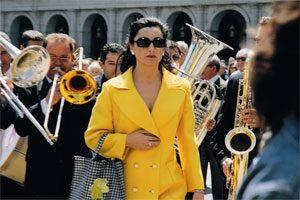Pilar Albarracín | Voices of Silence
Prohibido el Cante, 2000, video performance, 6:20 min
In her works, Pilar Albarracín undermines the anthropological roots of her Spanish identity and culture. Via humor and cynicism she criticizes and subverts prevalent hackneyed myths. The video performance Prohibido el Cante (‘Singing Prohibited’) alludes to various aspects of Spanish history and Andalusian culture to which the artist belongs. In a typical tavern, alongside a guitarist, the artist emerges as a flamenco singer, wearing a flamenco dress in camouflage colors, with coquettish earrings and heavy make-up. When she starts singing, desperate cries come out of her throat, like a wordless lamentation breaking out of the body and intensifying until it reaches a peak. At that moment the artist pulls out a knife, wounds her body, tears her heart out and throws it on the floor before the cheering audience. She is carried into the song, radicalizing the drama and constructing an erotic, sexual figure that moans in pain to the bitter end, where she gives her heart and sacrifices herself.
Pulling out the heart – the most protected, internal, intimate organ – is akin to the eradication of emotion. Albarracín is determined to fight the roots of her pain to the point of self-sacrifice. The military dress with the camouflage print likewise illustrates the spirit of struggle and rebellion emerging from tradition, but the sacrifice and struggle can also be read as defiance and ridicule of flamenco culture, and as criticism of its extroverted, stormy nature and demanding claims. One may say that the ecstasy and exaggeration have ultimately led to the violent act and the body’s mutilation, but at the same time also brought about the therapeutic liberation and redeeming catharsis.
The tavern wall bears the inscription “Singing prohibited” from which the work takes its title. The prohibition refers to the era of Franco’s dictatorship over Spain from 1939 until his death in 1975. Franco strove for a unified, strong Spain; he objected to cultural diversity between communities and forcefully repressed distinguishing cultural peculiarities, such as language, customs, and any other element deviating from the Spanish hegemony. Thus he also censored and restricted the flamenco culture originating in Andalusia, in an attempt to minimize its eruptive nature and render it a banal, national folklorist art, and to prevent overly-merry gatherings, such as in taverns.
